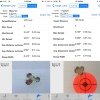I am certain the energy input of the cartridge makes a huge difference. The barrel is vibrating dynamically and it responds to whatever masses are on it, and to what ever is touching
View attachment 865940
View attachment 865941
this rifle was stocked in best 1950's manner: the barrel was completely in contact with the fore end. Joe, the guy from who I bought the thing, had bedded the barrel such that a dollar would not slide between the barrel and fore end.
View attachment 865942
View attachment 865943
I free floated the barrel, completely removed contact with the fore end, and got roundish groups
View attachment 865944
This is a classic British Smallbore Prone rifle. And it is based on a classic action, the Martini Henry. Those old black powder rifles, the fore ends were in complete contact with the barrel, and competitors of the era shot some great scores with their smoke poles. When it came to making a 22lr, the Brits copied many things from the centerfire rifles, one of which was a fore end in contact with the barrel.
View attachment 865945
View attachment 865946
That big screw on the right holds the fore end to the barrel
View attachment 865947
Even though the sling pulls on the forend, and I change the mass by sticking a scope on the barrel, I do not notice any diminished accuracy with a scope.
View attachment 865948
View attachment 865949
View attachment 865950
I prefer Redfield 3200's, and took it to a match in Sept and shot this at 100 yards. These are the best targets. It was hot and that really affects my pulse. When it is 88 F in the shade, only the crazies are out shooting in quilted coats and sweat shirts!
View attachment 865951
So, I believe that given a stiff enough structure, such as the Martini action, and a low enough cartridge energy input, that masses on the barrel and the pressure of the cartridge, don't make a big difference on point of impact. But go the other way, light barrels, high pressure, and contact points, and the dynamics are irregular.










